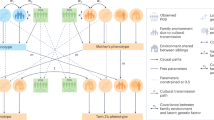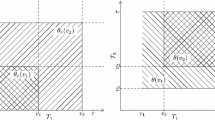Abstract
There has been considerable interest in studying the magnitude and type of inheritance of specific diseases. This is typically derived from family or twin studies, where the basic idea is to compare the correlation for different pairs that share different amount of genes. We here consider data from the Danish twin registry and discuss how to define heritability for cancer occurrence. The key point is that this should be done taking censoring as well as competing risks due to e.g. death into account. We describe the dependence between twins on the probability scale and show that various models can be used to achieve sensible estimates of the dependence within monozygotic and dizygotic twin pairs that may vary over time. These dependence measures can subsequently be decomposed into a genetic and environmental component using random effects models. We here present several novel models that in essence describe the association in terms of the concordance probability, i.e., the probability that both twins experience the event, in the competing risks setting. We also discuss how to deal with the left truncation present in the Nordic twin registries, due to sampling only of twin pairs where both twins are alive at the initiation of the registries.


Similar content being viewed by others
References
Bandeen-Roche K, Liang K-Y (2002) Modelling multivariate failure time associations in the presence of a competing risk. Biometrika 89:299–314
Bandeen-Roche K, Ning J (2008) Nonparametric estimation of bivaiate failure time associations in the presence of a competing risk. Biometrika 95:221–232
Chen BE, Kramer JL, Greene MH, Rosenberg PS (2008) Competing risks analysis of correlated failure time data. Biometrics 64:172–179
Cheng Y, Fine JP, Kosorok MR (2007) Nonparametric association analysis of bivariate competing-risks data. J Am Stat Assoc 102:1407–1415
Falconer D (1967) The inheritance of liability to diseases with variable age of onset, with particular reference to diabetes mellitus. Ann Hum Genetics 31:1–20
Falconer D, Mackay T (1994) Introduction to quantitative genetics. Addison-Wesley, New York
Fine JP, Gray RJ (1999) A proportional hazards model for the subdistribution of a competing risk. J Am Stat Assoc 94:496–509
Geskus R (2010) Cause-specific cumulative incidence estimation and the Fine and Gray model under both left truncation and right censoring. Biometrics 67:39–49
Glidden DV (2000) A two-stage estimator of the dependence parameter for the Clayton-Oakes model. Lifetime Data Anal 6:141–156
Gorfine M, Hsu L (2011) Frailty-based competing risks model for multivariate survival data. Biometrics 67:415–426
Hougaard P (2000) Analysis of multivariate survival data. Statistics for biology and health. Springer, New York
Katsahian S, Resche-Rigon M, Chevret S, Porcher R (2006) Analysing multicentre competing risks data with a mixed proportional hazards model for the subdistribution. Stat Med 25:4267–4278
Lichtenstein P, Holm N, Verkasalo P, Iliadou A, Kaprio J, Koskenvuo M, Pukkala E, Skytthe A, Hemminki K (2000) Environmental and heritable factors in the causation of cancer-analyses of cohorts of twins from Sweden, Denmark, and Finland. New Engl J Med 343:78
Locatelli I, Lichtenstein P, Yashin A (2004) The heritability of breast cancer: a Bayesian correlated frailty model applied to Swedish twins data. Twin Res Hum Genetics 7:182–191
Locatelli I, Rosina A, Lichtenstein P, Yashin A (2007) A correlated frailty model with long-term survivors for estimating the heritability of breast cancer. Stat Med 26:3722–3734
Neale MC, Cardon LR (1992) Methodology for genetic studies of twins and families. Kluwer Academic Publishers, Dordrecht
Pinborg A (2005) IVF/ICSI twin pregnancies: risks and prevention. Human reproduction update 11:575–593
Ripatti S, Gatz M, Pedersen N, Palmgren J (2003) Three-state frailty model for age at onset of dementia and death in Swedish twins. Genetic Epidemiol 24:139–149
Risch N (1990) Linkage strategies for genetically complex traits. i. multilocus models. Am J Hum Genetics 46:222
Scheike TH, Sun Y (2012) On cross-odds ratio for multivariate competing risks data. Biostatistics 13:680–694
Scheike TH, Zhang M-J, Gerds T (2008) Predicting cumulative incidence probability by direct binomial regression. Biometrika 95:205–20
Scheike TH, Sun Y, Zhang MJ, Jensen TK (2010) A semiparametric random effects model for multivariate competing risks data. Biometrika 97:133–145
Sham P (1998) Statistics in human genetics. Arnold application of statistics
Skytthe A, Pedersen N, Kaprio J, Stazi M, Hjelmborg J, Iachine I, Vaupel J, Christensen K (2003) Longevity studies in GenomEUtwin. Twin. Res. 6:448–454
Zhang X, Zhang M, Fine J (2011) A proportional hazards regression model for the subdistribution with right-censored and left-truncated competing risks data. Stat Med 30:1933–1951
Acknowledgments
We appreciate constructive and useful comments from the Associate editor and two referees that have improved the presentation of our paper considerably and have raised several interesting issues. We thank our collaborators at the NorTwinCan consortia for stimulating discussions about the twin data.
Author information
Authors and Affiliations
Corresponding author
Rights and permissions
About this article
Cite this article
Scheike, T.H., Holst, K.K. & Hjelmborg, J.B. Estimating heritability for cause specific mortality based on twin studies. Lifetime Data Anal 20, 210–233 (2014). https://doi.org/10.1007/s10985-013-9244-x
Received:
Accepted:
Published:
Issue Date:
DOI: https://doi.org/10.1007/s10985-013-9244-x




